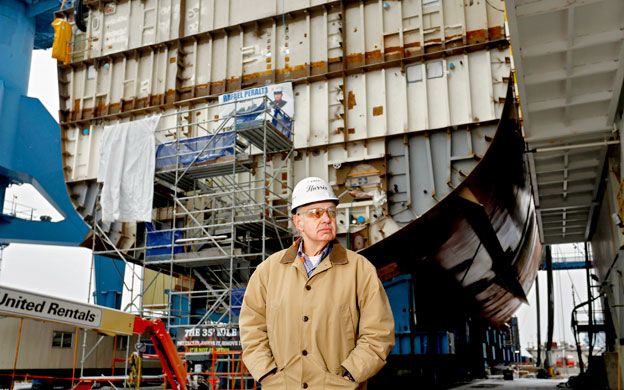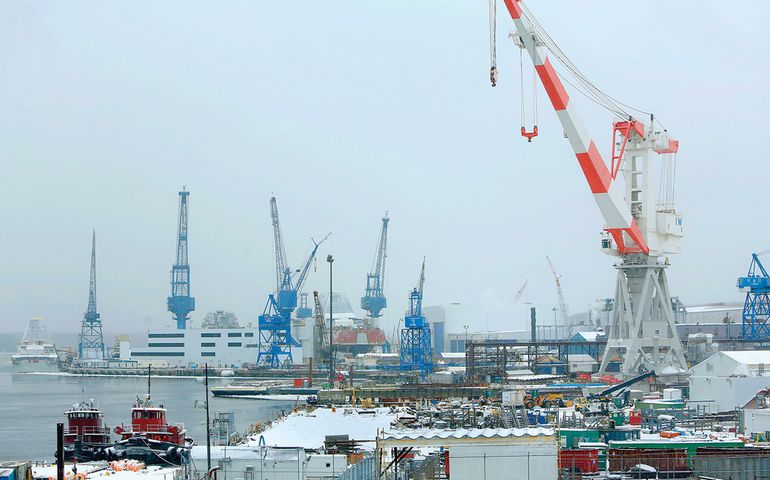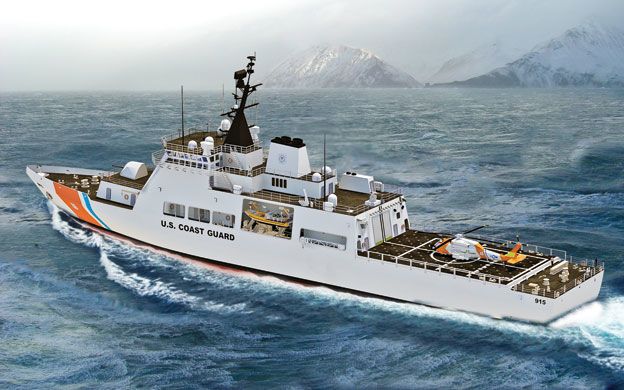The future is now: BIW shipyard looks to cut costs to win major Coast Guard contract
Since August, Bath Iron Works President Fred Harris has been hosting 90-minute meetings with small groups of shipyard workers to identify the challenges they face in an era of declining Navy spending on the Aegis destroyers, which have been the Bath shipyard's mainstay since the early 1990s. A mainstay of his presentation is a graph that looks like a steep slope on Sugarloaf Mountain.
“I do not want Bath to look like this,” he says, noting that the chart depicts the loss of 30,000 manufacturing jobs in Maine since 2000.
But there's a very real possibility the employment trend line for BIW could look that way, with roughly 1,200 of its 5,700 workers potentially facing layoffs when the last of three DDG 1000 destroyers is delivered to the Navy sometime in 2019. The end of that program coincides with a Navy procurement schedule that budgets fewer DDG 51 destroyers for the foreseeable future, which tightens the competition between BIW and the Huntington Ingalls Industries shipyard in Pascagoula, Miss. An added layer of concern is the return in 2016, after a two-year pause, of the funding limits imposed by the 2011 Budget Control Act — which could set the stage for sequestration forcing mandatory cuts in the Defense budget and the possibility that the Navy will have to cut its 2017, 2018 and 2019 shipbuilding budgets even more if Congress doesn't raise the funding limit.
All those uncertainties heighten the importance of the competitive bid against two southern shipyards that BIW is preparing for up to 25 offshore patrol cutters for the U.S. Coast Guard. With an estimated total acquisition cost of $12.1 billion, or an average cost of roughly $484 million per ship, that program would help stabilize BIW's workforce in an era of tighter Navy budgets and essentially cancel the layoffs resulting from the completion of the DDG 1000 program by the end of the decade.
“It's a must-win for us,” Harris says of the Coast Guard OPC bid the shipyard will submit later this year or in early 2016. “In the next year and a half to two years, we will set the table for Bath with work in front of us for many years to come — or not. There's a greater sense of urgency today here than there has been in years … I think everyone who works here understands we, collectively, have to get more competitive. If we don't, the shipyard could go the way of other Maine industries, such as the paper mills.”
Coast Guard cutters
Last February, the Coast Guard winnowed the field of eight bidders down to three, including BIW. Along with Bollinger Shipyards Inc. in Lockport, La., and Eastern Shipbuilding Group Inc. in Panama City, Fla., BIW was asked to come up with preliminary designs and cost estimates to build up to 25 offshore patrol cutters. The initial work includes a $21 million contract to design patrol cutters capable of operating in high seas more than 50 miles offshore. The offshore patrol cutters would replace the Coast Guard's fleet of 210-foot and 270-foot cutters, some of which are more than 40 years old.
Harris characterizes Bollinger and Eastern as “very effective, very flexible yards,” which pay lower wages and generally have lower utility costs than BIW. “They're very quick on their feet,” he says. “They turn work around quickly and they allow people to cross trades … for example, if a painter is not busy he can help pull cable and if a cabler is not busy he can help mask and paint.”
Pluses for BIW, he says, include its “extremely talented engineering force and planning people” and “extremely experienced mechanics” whose skills have been benchmarked as being “as good or better” than their counterparts at one of the world's leading shipyards in South Korea. He's confident BIW's final proposal “will be a very well-designed and very well-thought-out ship.”
But those strengths won't be enough to win the work, Harris says, if BIW doesn't find ways to “mitigate and eliminate” the southern yards' cost advantages.
A Jan. 5 congressional briefing prepared by Ronald O'Rourke, a naval affairs specialist for the Congressional Research Service, leaves no doubt that the Coast Guard, no less than the Navy, is feeling budget pressures as it embarks on the most expensive acquisition program in its history. O'Rourke quotes an exchange between Coast Guard Adm. Robert J. Papp and the House Appropriations Committee during a hearing on the Coast Guard's fiscal year 2013 budget in which Papp, who has since retired, explained how the OPC construction bids would be evaluated:
“We needed to build a ship that was affordable,” Papp told the committee. “We have battled ourselves within the Coast Guard to make sure we're asking for just exactly what we need, nothing more, nothing less. And I have said three things to my staff as we go on forward — affordable, affordable, affordable.”
O'Rourke's analysis spells out the Coast Guard's three assumptions guiding its cost estimates for the OPC program:
• The winning shipyard(s) will generally continue to reduce the labor hours required to build the OPC through the production of all 25 vessels.
• Upwards of 55% of the cutter's construction and material costs would reflect commercial ship construction standards and 45% the higher standards followed in the construction of Navy combat vessels.
• The production schedule would switch from one ship to two ships per year starting with the fourth and fifth vessels.
“It all boils down to cost,” says Harris.
Top-to-bottom effort
Since becoming BIW's president in November 2013, Harris has focused on improving the shipyard's training, planning and manufacturing practices, all with the goal of becoming more competitive in an increasingly tough shipbuilding environment. General Dynamics Corp., BIW's Falls Church, Va.-based owner, has invested more than $70 million in shipyard improvements in the last couple of years, including:
• A new 51,315-square-foot Outfitting Hall adjacent to Ultra Hall (a $40 million facility completed in 2008) that will enhance the shipyard's capability of building ship modules of up to 5,000 tons in a controlled environment. The facility is scheduled to be completed by late summer.
• A new blast and painting facility capable of handling three-deck-high units, also slated to open by summer.
• A new 6,000-square-foot Trades Learning Center that opened last spring, where even the most experienced of new hires must take a rigorous six-week training program before working on a DDG-51 or DDG-1000 destroyer.
The training effort, says Harris, is a crucial element of the shipyard's cost-cutting efforts. Last year the shipyard hired 500 workers, with more than 400 of them being tradesmen. This year, he expects to hire another 440 to 500 workers, with up to 450 being tradesmen. With 40% of its workforce being between the ages of 55 and 65, roughly half of those new hires are driven by a need to replace the shipyard's most skilled tradesmen — many with 30 or more years of experience — who are retiring at a rate of 200 to 250 workers per year. It's a trend that's expected to continue for at least the next five years.
“It takes about five years for a first-class mechanic to mature to the point where he or she can work independently,” says Harris, a graduate of Maine Maritime Academy whose shipbuilding career began in 1973 as a senior engineer for the Trident ballistic missile submarine program at Electric Boat in Groton, Conn. “So it's a major investment by the corporation in training individuals to be shipbuilders.”
The shipyard's challenge is to reduce the learning curve as quickly as possible, he says, in order to keep production hours at or below the shipyard's past performance standards. At the same time, he adds, the shipyard is making a concerted effort to write down, as much as possible, the “oral tradition” of the most-experienced tradesmen before they retire.
“We have a group of people today whose only job is to understand how to incorporate those lessons learned — not only from past DDG 51s and from the DDG 1000s, not only lessons learned from other shipyards, but also the input we get from our customer, the Navy,” Harris says. “It's a question of capturing the thousands of lessons learned in order to make our ships more affordable in the future.”
A major focus this year, he adds, will be improving the flow of materials to mechanics and other tradesmen by applying “just-in-time” manufacturing principles throughout the shipyard.
“It's all about process,” Harris says. “We just don't have the processes in place yet to make it very affordable to build ships here. We need to make sure the mechanic gets what he needs first thing in the morning, on time, not too early and not too late, so he doesn't have to travel all around the shipyard looking for it. We also don't want to give him six months' of material and tell him to go build it. He'll just look at it and say, 'Where am I going today?'”
Those efforts are beginning to pay off, with Harris citing as one example a pipefitter who demonstrated how a two-and-a-half-hour job could be reduced to half an hour simply by using different equipment. “It's hard work,” he says. “There are many many people here at Bath who are spending long hours trying to plot the way forward so we can perform well on the backlog and help us have a chance to go in and get the future work we want to get. But it will take all of us. It's all going to be done with the team.”
Outsourcing to reduce costs?
Reducing production costs isn't only about winning the Coast Guard's OPC contract in 2016; it very much relates to BIW's future opportunities in the Navy's DDG 51 destroyer program, which ended in 2008 and then restarted in 2010 after the Navy opted not to continue the DDG 1000 program beyond the first three ships built in Bath. The shipyard will be competing once again against archrival Ingalls in a multi-year DDG 51 bid later this year.
Harris says in the last competition with Ingalls — a multi-year award in 2013 for nine ships, with the possibility of a tenth ship being added later — BIW came out on the short end of a 4-5 split. Although the Navy later added a fifth ship to BIW, Harris says the inescapable fact is that the shipyard's costs were higher than its Gulf Coast competitor. “It's a very, very major wake-up call for this shipyard,” he says.
This past year, Harris says, BIW has benchmarked with the General Dynamics Electric Boat shipyard in Groton and the Nassco shipyard in San Diego (where Harris also is president), as well a shipyard in South Korea. Those comparisons, as well as a 2005 benchmarking study involving 11 Navy shipyards and suppliers, he says, identified another cost-cutting opportunity: “regionalized outsourcing” of work that could be done more cheaply outside the shipyard.
“BIW is the exception,” Harris says. “What we've proposed to our bargaining unit, in accordance with the union contracts, is just catching up with everyone else: Every other shipyard in the United States, and in the world, basically buys those things they can buy outside at a cheaper price than they can make them themselves.”
Jay Wadleigh, president of Local S6 of the Machinists union, which represents more than 3,300 shipyard workers, says his members fully support the company's overarching goal of becoming “as cost-efficient as possible in order to be competitive.” But after spending upwards of 1,000 hours collectively reviewing the company's 1,250-page proposal to outsource as many as 11 ship components to subcontractors outside the shipyard, he says Local S6 leaders “can see no tangible proof” that outsourcing would reduce the shipyard's costs.
Wadleigh says the company's proposal for outsourcing would send out work on electrical panels, lockers, bunks and dressers, sinks and kitchen items, doors and hatches, as well as industrial diving to check on hulls once the ships are in the water.
“The numbers they gave us, in some instances, we found were inaccurate,” he says. “In other instances we found the cost savings were inflated. In some cases, we determined outsourcing the work might cost the shipyard more … We've determined that the savings are really de minimis.”
Wadleigh says the original Jan. 8 deadline has been extended to Jan. 30, when the union will either accept or reject the company's outsourcing proposal, or make a counter-proposal of its own. If, at that point, the company and union can't reach an agreement, he says the contract spells out a process for resolving differences. If there's still no resolution, he says, it would go to fast-track arbitration.
“There are lots of process improvements we should be doing — things that, if fixed, will create some significant savings,” he says. “That's how we're going to get there … You need to tap the members, incorporate their ideas on how we can be more efficient and make that work.”
Across the street, Harris keeps an open door at his office, where he generally arrives by 5:15 a.m. In those shipyard meetings, he says, his basic message has been, 'I need your help. How can we get better?'” He's pleased that more than one mechanic has shown up at his office with a cost-saving idea. He recognizes the outsourcing proposal is controversial, but believes it's an essential step in ensuring the shipyard's future viability.
“If I took all those jobs [on the company's outsourcing proposal] and moved them out the door, I would still need to hire more people,” he says. “This is not a question of people losing their jobs. It's a question of being able to get the work done affordably in order to win more work.”
Read more
Three industries take ownership of their worker training needs
Decades of tide changes: Investments help Bath Iron Works maintain its shipbuilding prowess
BIW target of federal harassment lawsuit
BIW gets $13M destroyer contract
As BIW adapts for future, labor unrest boils over
Union sues BIW over job description changes
BIW seeks dismissal of union lawsuit
Court sides with BIW in union dispute
BIW and union negotiators agree to proposed contract
Proposed BIW union contract faces resistance despite compromises















Comments